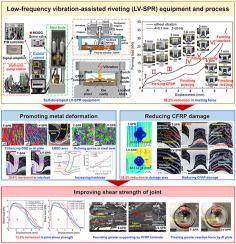当前位置:
X-MOL 学术
›
Int. J. Mach. Tool Manu.
›
论文详情
Our official English website, www.x-mol.net, welcomes your feedback! (Note: you will need to create a separate account there.)
Low-frequency vibration assisted self-pierce riveting (LV-SPR) of carbon fiber reinforced composite and aluminum alloy
International Journal of Machine Tools and Manufacture ( IF 14.0 ) Pub Date : 2024-03-18 , DOI: 10.1016/j.ijmachtools.2024.104147 Cong Shao , Jun Lin , Yanjin Guan , Dong Quan , Liang Chen , Cunsheng Zhang , Guoqun Zhao
International Journal of Machine Tools and Manufacture ( IF 14.0 ) Pub Date : 2024-03-18 , DOI: 10.1016/j.ijmachtools.2024.104147 Cong Shao , Jun Lin , Yanjin Guan , Dong Quan , Liang Chen , Cunsheng Zhang , Guoqun Zhao

|
Self-pierce riveting (SPR) has been widely applied to join carbon fiber-reinforced polymer (CFRP) composites and high-strength metallic plates in the automotive and aerospace fields. However, the CFRP is often damaged by rivet piercing owing to its brittleness as well as the relatively small interlocking that forms between the rivet leg and high-strength plate owing to the hard deformation characteristics. Therefore, in this study, a novel low-frequency vibration-assisted self-pierce riveting (LV-SPR) technology is proposed, which utilizes the vibration effect in softening the metal and reducing interfacial friction at room temperature. In riveting experiments involving CFRP and 5052 aluminum alloy utilizing 37Cr4 semi-hollow rivets, LV-SPR exhibited a significant reduction of 68.2% in the riveting force compared to the traditional SPR process. The decreased riveting pressure in LV-SPR effectively mitigated the CFRP damage by 36.2%, which was caused by a reduction in the interfacial friction force between the rivet and CFRP laminate. Moreover, owing to the improved deformation capacity of the rivet and alloy plate by the vibration softening effect, the lateral expansion of the rivet leg in the aluminum alloy was enlarged by 36.4% compared to that using the traditional self-piercing riveting (T-SPR) process. Microscopic characterization revealed that vibrations notably promoted grain refinement and enlarged the subgrain structures of the rivets and alloy plates. Finally, by superposing oscillations, the shear strength of the connection joint increased by 13.5% compared to the T-SPR joint. The proposed LV-SPR was validated as an effective technique to increase the connection strength of high-performance plates, which can efficiently improve the structural safety and promote the widespread application of CFRP/alloys in automobiles and aircrafts.
中文翻译:

碳纤维增强复合材料与铝合金的低频振动辅助自冲铆接(LV-SPR)
自冲铆接(SPR)已广泛应用于汽车和航空航天领域的碳纤维增强聚合物(CFRP)复合材料和高强度金属板的连接。然而,CFRP由于其脆性以及由于硬变形特性而在铆钉腿和高强度板之间形成的相对较小的互锁,经常被铆钉刺穿损坏。因此,本研究提出了一种新型低频振动辅助自冲铆接(LV-SPR)技术,该技术利用振动效应软化金属并减少室温下的界面摩擦。在使用37Cr4半空心铆钉进行CFRP和5052铝合金的铆接实验中,与传统SPR工艺相比,LV-SPR的铆接力显着降低了68.2%。 LV-SPR 中铆接压力的降低有效地将 CFRP 损坏减轻了 36.2%,这是由于铆钉和 CFRP 层压板之间的界面摩擦力减少所致。此外,由于振动软化效应提高了铆钉和合金板的变形能力,铝合金铆钉腿的横向膨胀量比传统自冲铆接(T-SPR)扩大了36.4% ) 过程。微观表征表明,振动显着促进了晶粒细化并扩大了铆钉和合金板的亚晶结构。最后,通过叠加振动,连接接头的剪切强度比T-SPR接头提高了13.5%。所提出的LV-SPR被验证是一种提高高性能板连接强度的有效技术,可以有效提高结构安全性并促进CFRP/合金在汽车和飞机上的广泛应用。
更新日期:2024-03-18
中文翻译:

碳纤维增强复合材料与铝合金的低频振动辅助自冲铆接(LV-SPR)
自冲铆接(SPR)已广泛应用于汽车和航空航天领域的碳纤维增强聚合物(CFRP)复合材料和高强度金属板的连接。然而,CFRP由于其脆性以及由于硬变形特性而在铆钉腿和高强度板之间形成的相对较小的互锁,经常被铆钉刺穿损坏。因此,本研究提出了一种新型低频振动辅助自冲铆接(LV-SPR)技术,该技术利用振动效应软化金属并减少室温下的界面摩擦。在使用37Cr4半空心铆钉进行CFRP和5052铝合金的铆接实验中,与传统SPR工艺相比,LV-SPR的铆接力显着降低了68.2%。 LV-SPR 中铆接压力的降低有效地将 CFRP 损坏减轻了 36.2%,这是由于铆钉和 CFRP 层压板之间的界面摩擦力减少所致。此外,由于振动软化效应提高了铆钉和合金板的变形能力,铝合金铆钉腿的横向膨胀量比传统自冲铆接(T-SPR)扩大了36.4% ) 过程。微观表征表明,振动显着促进了晶粒细化并扩大了铆钉和合金板的亚晶结构。最后,通过叠加振动,连接接头的剪切强度比T-SPR接头提高了13.5%。所提出的LV-SPR被验证是一种提高高性能板连接强度的有效技术,可以有效提高结构安全性并促进CFRP/合金在汽车和飞机上的广泛应用。












































 京公网安备 11010802027423号
京公网安备 11010802027423号